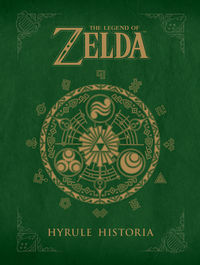 On January 29, The Legend of Zelda: Hyrule Historia will be released, but it was almost one year ago, February 6, 2012, that Nintendo contacted us to see if we were interested in doing the localization, and it was shortly thereafter that I first held Shogakukan’s Hyrule Historia in my hands and said, “Wow.” I cracked the spine and pored over every single page. I wanted to soak in every character design, every historical detail, every beautiful piece of artwork. This was a world that I thought I knew so well, and Hyrule Historia managed to enrich every aspect of every game and the mythology surrounding them. It made me want to go back to the very beginning, The Legend of Zelda, and play through every game again, scouring them for details, looking at them through new eyes. And I did. And it was more rewarding than I could ever have imagined.
On January 29, The Legend of Zelda: Hyrule Historia will be released, but it was almost one year ago, February 6, 2012, that Nintendo contacted us to see if we were interested in doing the localization, and it was shortly thereafter that I first held Shogakukan’s Hyrule Historia in my hands and said, “Wow.” I cracked the spine and pored over every single page. I wanted to soak in every character design, every historical detail, every beautiful piece of artwork. This was a world that I thought I knew so well, and Hyrule Historia managed to enrich every aspect of every game and the mythology surrounding them. It made me want to go back to the very beginning, The Legend of Zelda, and play through every game again, scouring them for details, looking at them through new eyes. And I did. And it was more rewarding than I could ever have imagined.
From the foreword from Shigeru Miyamoto to the afterword by Eiji Aonuma, this book is absolutely packed with information and beautiful artwork. Hyrule Historia is broken down into four different sections:
The first section is called “The Legend Begins,” and it’s sixty pages dedicated exclusively to the design and development of The Legend of Zelda’s latest installment, Skyward Sword. There is absolutely fascinating commentary from the designers and planners about the development of characters and locations, designs and ideas that didn’t make it into the game, backstory, game play, and final versions of all the major players from the game. Did you know that all the characters in Skyloft are modeled after birds, or that the Mogmas nearly got a more primitive design, since this game is supposed to take place in Hyrule’s ancient past? You can read all about it and see the initial designs in this chapter.
The second section is called “The History of Hyrule” and contains the official version of the timeline that has spawned so many fan theories. This chapter is written chronologically by which games come first in the history of Hyrule, starting with the creation of the land by the goddesses, and explains how each game fits together.
The third section is called “Creative Footprints.” It contains nearly a hundred pages of designs, notes, and art from every Zelda game from the original to Spirit Tracks. There are images that are being published for the first time, including dungeon configurations worked out on graph paper from The Legend of Zelda and a map of the changes in character design from game to game.
The last section is an exclusive Skyward Sword manga by Akira Himekawa. It serves as an introduction to the events of Skyward Sword, but it has a good deal of the creation story of Hyrule mixed with it. It’s beautiful, and a must-read for any Zelda fan.
A lot of the artwork has handwritten notes from the designers in it. Don’t worry. We translated every last character into English, even stuff that was not legible in the original version of the book. We did not leave anything out. If you ever run into any of the translators on this book, please buy them a drink. Some of the creators’ handwriting is atrocious! It took hours upon hours to translate everything and make sure that it was correct, but it was absolutely worth it just to see what went into making every character, every location, unique.
On a personal note, this has been a year of extremely hard work by a lot of different people at Dark Horse and Nintendo. I want to thank them all for making this one of the best books I’ve ever had the privilege of working on. Everyone that worked on the book is a huge Zelda fan, and we worked really hard to make this a book that you are going to hold in your hands and say, “Wow.” I hope that you, like me, pore over every page, find things that surprise and excite you, and go back, blow out the back of your The Legend of Zelda cartridge, and tackle the whole saga with brand-new eyes. Please, enjoy this 276-page tribute to the greatest game series of all time.
The Legend of Zelda: Hyrule Historia Editor - Patrick Thorpe